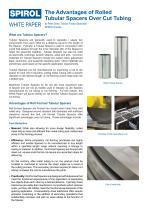 Website:
SPIROL
Website:
SPIROL
Catalog excerpts

WHITE PAPER The Advantages of Rolled Tubular Spacers Over Cut Tubing by Peter Grant, Tubular Product Specialist SPIROL Canada What are Tubular Spacers? Tubular Spacers are generally used to separate / space two components from each other by a distance equal to the length of the Spacer. Typically, a Tubular Spacer is used in conjunction with a bolt that passes through the inner diameter (ID) of the Spacer to retain the assembly together. Tubular Spacers can also be used as stand-offs, bushings, tension sleeves, axles and pins. Common materials for Tubular Spacers include low carbon steel, galvanised steel, aluminium, and austenitic stainless steel. Other materials are sometimes used based on the specific application requirements. Tubular Spacers can be manufactured by machining a rod to the proper ID (and OD if required), cutting metal Tubing with a specific diameter to the desired length, or roll forming coiled metal strip into a butted tube. Machined Tubular Spacers by far are the most expensive type of Spacer and are not as readily used in industry as are Spacers manufactured by cut tubing or roll forming. For this reason, this White Paper will focus entirely on roll formed Tubular Spacers and cut tubing. Rolled Tubular Spacers Advantages of Roll Formed Tubular Spacers Roll formed Spacers are formed into closed seam tubes from cold rolled strip. Designed around standard bolt diameters with sufficient clearance around the bolt, roll formed Tubular Spacers offer significant advantages over cut tubing. These advantages include: Cost Reduction • Material: While also allowing for more design flexibility, coiled metal strip is more cost-efficient than metal tubing and creates less scrap in the forming process. Examples of how metal tubing is cut • Efficiency: Some proprietary roll forming processes are highly efficient and enable Spacers to be manufactured to any length within a specified length range without requiring a change to tooling or material. In addition, roll formed Spacers are formed with clean-cut, square ends that do not require any secondary steps for deburring. On the contrary, after metal tubing is cut, the product must be tumbled or machined to remove the sharp edges as a result of the cutting process. This secondary process required to deburr cut tubing increases the cost to manufacture the parts. • Practicality: Roll formed Spacers are designed with tolerances that meet the functional requirements of the application of separating two objects from each other by a desired distance. Typically, these tolerances are wider than machined or cut products which reduces costs, yet they still reliably meet the functional requirements of the spacing application. Unnecessarily close tolerances often require precision machining or the addition of secondary operations that substantially increase cost with no value added to the function of the Spacer.
Open the catalog to page 1
Design Flexibility Innovative fastening solutions. Lower assembly costs. • Since most Tubular Spacers are used to separate two objects by a desired distance and the assembly is normally fastened together by a bolt passing through the ID of the Spacer, manufacturers typically only control the ID and length of the Spacer. So as to not over-specify the product with no added value, the outer diameter (OD) of a Tubular Spacer is generally a reference dimension since the parts are not meant for installation into a hole or bore. When specific applications require a custom Tubular Spacer,...
Open the catalog to page 2All SPIROL catalogs and technical brochures
-
Alignment Dowels/Bushings
12 Pages
-
Compression Limiter Design Guide
20 Pages
-
Slotted Spring Pins
16 Pages
-
Latch Pins for Plastics
2 Pages
-
Railroad Nuts - AAR Series
2 Pages
-
SPIROL Corporate Brochure
12 Pages
-
Disc Springs
20 Pages
-
Coiled Spring Pins
24 Pages
-
Series RH600 Twist-Lok™ Pins
2 Pages
-
Cosmestic Pins 550 series
2 Pages
-
Installation Technology
8 Pages
-
SPIROL Precision Shims
8 Pages
-
Medical Device Applications
2 Pages
-
SPIROL Solid Pins Catalog
12 Pages
-
Series 2000 Series 2000
4 Pages
-
Aerospace Applications Flyer
2 Pages
-
PH series PH series
2 Pages
-
HC series HC series
2 Pages
-
Tables Standard
2 Pages
-
Tables Lift and Roll
2 Pages
-
SPD, CXA, CXD, CXE CRD
2 Pages
-
880 Series
2 Pages
































































